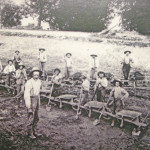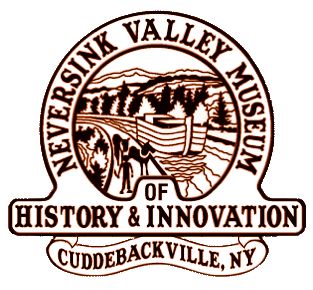Here Come the Navvies
 In 1826, 2,100 workers known as “navvies” began work on the D&H Canal. “Navvy” was originally a British term; a shorthand for “navigator”. From the late 1700’s on, navvies built the canals or “navigations” that criss-crossed England. That tradition continued on in America. Within three years the navvies had completed their work on the D&H and the 108 mile long canal opened for business in 1828.
In 1826, 2,100 workers known as “navvies” began work on the D&H Canal. “Navvy” was originally a British term; a shorthand for “navigator”. From the late 1700’s on, navvies built the canals or “navigations” that criss-crossed England. That tradition continued on in America. Within three years the navvies had completed their work on the D&H and the 108 mile long canal opened for business in 1828.
Most of the navvies who worked on American canals were Irish immigrants. Well before the potato famine of 1845, the Irish were already leaving their homeland in search of freedom and opportunity. Since the 18th century the Irish rural population had been gradually disconnected from their farms. Landlords had been confiscating their land and evicting the peasants. The Irish rural class was driven into poverty and started to seek their future through immigration. Many Irish immigrants to our shores brought with them skills they had developed back home. Others brought a strong back and the willingness to do hard labor.
As the story goes, the D&H Canal was built with picks, shovels, wheelbarrows and strong backs. Whilst true to some extent, its only part of the story. Animal power was certainly an important resource. Draught horses and oxen carried the stones that would be used in building various canal structures. The animals would also be used at times to drag scoops along the canal-way to help create the trench which would eventually hold the canal water.
Wagons loaded with clay that would be used to waterproof the canal were also pulled by the work animals. This clay would be “puddled” to seal the canal bed wherever it was prone to water leaks. The Summit section from Cuddebackville to Summitville in particular had light, sandy or gravely soil and was prone to leakage. Puddling involved applying several layers of clay to the canal bed, working and chopping the clay with spades and then pounding it into place. The technique was first used in England and copied widely in America and was very effective in making canals watertight.
Stone played a very important part in the building of the D&H. Both its removal from the canalway and its use to build canal walls, locks, guard gates, waste weirs, culverts, aqueducts, dry docks and the foundations for the various D&H buildings required special skills. Some of the workers were skilled in demolishing stone from the canal path and blasting the stone in the quarries. They were called “blasters”.
The blasters were especially adept in drilling powder holes by hand in the rock and filling them with blasting powder. Once filled, a fuse made of brown paper soaked with saltpeter was inserted and held in place with a plug of clay. There was much skill involved in creating the fuse. Too much saltpeter and the blast would happen too quickly to the peril of the blaster. Too little and the fuse would burn too slowly. Many blasters returning to relight a burned out fuse found out to their dismay that the fuse was still alight!
When fieldstone wasn’t sufficient to meet local construction needs, stone was quarried from nearby mines. Working with the blasters, quarrymen would mine the stones needed for the canal. Stone cutters then dressed the quarried stones. Finally, the masons would use the cut stone to build the various structures called for in the canal plans.
Whilst the original D&H locks were mostly constructed of cut stone and mortar, in 1850, after the second and last canal enlargement, only 13 of the D&H locks were made of cut and dressed stone. The other 95 locks were wood lined and backed with six foot thick walls of uncut dry-laid stones. Where cut stone was used, the lock walls were thinner and hydraulic cement from Rosendale was used since it bound the stones together and kept the lock’s walls from collapsing. Chamber wall collapse was a very real concern given that the walls were over 15 feet high. Rosendale cement was used along the entire length of the canal wherever masons were called upon to employ their skills with mortar.
Experienced Irish stonemasons were important in the building of the canal. They had honed their skills in Ireland and brought them to the New World where they left their mark. For at least 5,000 years, building stone walls had been an important Irish occupation. Out of a utilitarian need to mark field boundaries and a good supply of field and quarried stone, the Irish stone wall tradition had developed. In fact, Irish stonemasons even had their own language, Bearlager na Saor. Today, over 250,000 miles of stone wall across all of Ireland stand as a testament to the masons’ skill.
An important group of Irish masons settled near Lewisville, Kentucky and plied their craft in the surrounding countryside. Their dry-laid stone fences bordered most fields and roads in the Inner Bluegrass area resulting in one of the largest group of quarried stone fences in North America. The mason’s art displayed by these Irish masons in Kentucky can also be found in their works on the D&H Canal.
Woodsmen worked all along the D&H route to cut down the trees on the canal path. The wood was frequently sawn into lumber that was used to construct the various buildings needed by the canal company. Crews of navvies would remove the brush and clear the roots and stumps that remained after the trees were felled. This practice was known as “grubbing”. The workers would also employ picks, shovels and wheel barrows to dig the canal trench as they proceeded along the canalway.
Carpenters and mechanics were also employed during the canal’s construction. Houses for the lock tenders and watchmen needed to be built and the lock mechanisms needed to be put into place at each of the 108 locks. Wheelwrights and blacksmiths were important, too, since the wagons used at the construction sites needed to be in good repair and the draught horses needed to be well shod.
To learn more about the Irish stonemasons and their New World legacy Irish Stone Walls by Pat McAfee and Rock Fences of the Bluegrass by Carolyn Murray-Wooley and Karl Raitz are most helpful. Peter Way’s Common Labor: Workers and the Digging of North American Canals, 1780-1860 is also a very good resource for background on the D&H workforce.
Copyright 2008 by Stephen Skye
Short Link:
